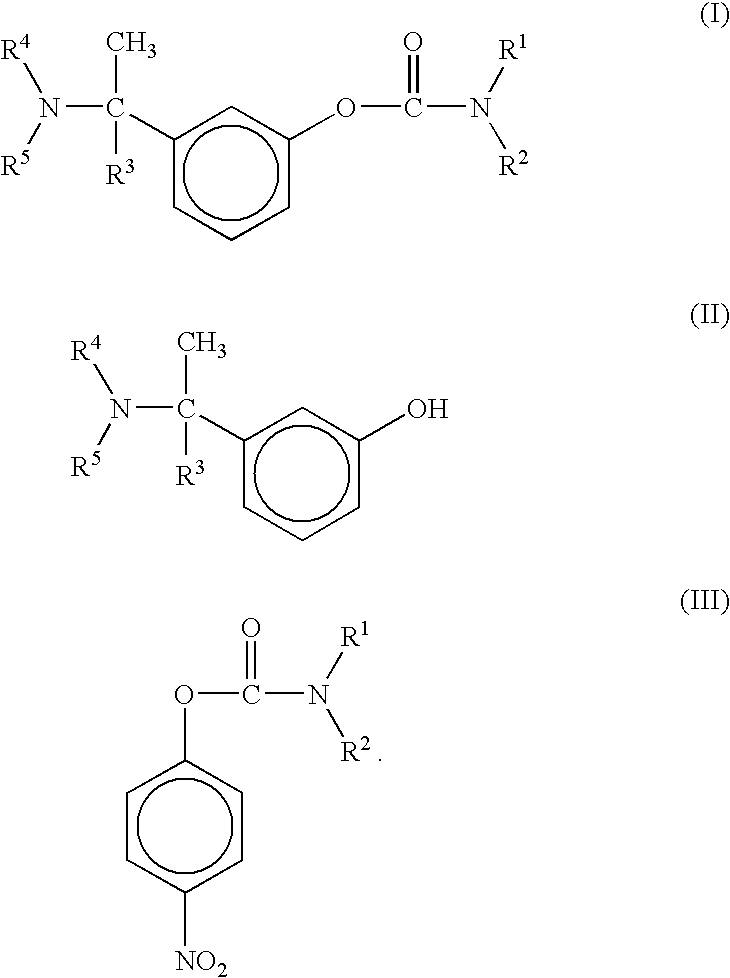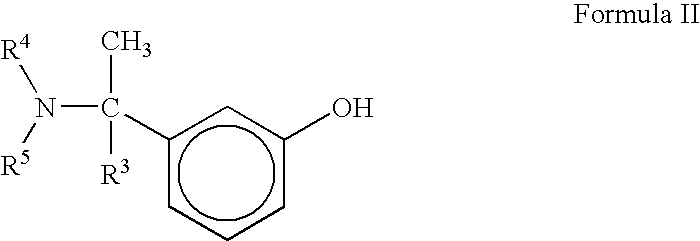Process for the preparation of phenylcarbamates
a technology of phenylcarbamate and process, which is applied in the preparation of carbamic acid derivatives, organic compound preparation, carbamoyl halide, etc., can solve the problems of hazardous handling of isocyanates such as lower alkyl isocyanates, unsafe use of reactive bases like sodium hydride on an industrial scale, and non-operational user-friendly effects
- Summary
- Abstract
- Description
- Claims
- Application Information
AI Technical Summary
Benefits of technology
Problems solved by technology
Method used
Image
Examples
example-1
a) Preparation of 3-(1-dimethylamino ethyl)phenol
Experimental Procedure
[0043]To the solution of 50% sulfuric acid in water (400.0 ml), was added at 10° to 15° C. temperature, DL-methionine (124.9 gm, 0.837 moles) and stirred for 15 minutes. To this solution, was added [1-(3-methoxyphenyl)ethyl]dimethylamine (100.0 gm, 0.553 moles) at 10° to 15° C. temperature within 2 hours and stirred for 30 minutes. Reaction mixture was then heated to 110° to 120° C. temperature for 28 hours.
[0044]The reaction mixture was diluted with water, basified to pH 8.5 to 9.0 using ammonia solution and extracted with dichloromethane. Organic extract was then washed with water, charcoalized and concentrated. Hexane was then added to the residue and crude product filtered.
b) Purification
[0045]Crude product was recrystallized from diisopropylether to give pure [1-(3-hydroxyphenyl)ethyl]dimethylamine (55.0 gm, 60% yield, Purity->99%) melting range: 85 to 86° C. temperature)
example-2
[0046]Preparation of N-ethyl-N-methyl-4-nitrophenyl carbamate
[0047]To the cooled solution (8-10° C.) of 50 gm (0.85 moles) N-ethyl-N-methylamine hydriiodide salt in 325 ml water, was added a solution of 75 gm (0.90 moles) Sodium bicarbonate in 1.0 L water maintained below 15° C. temperature. After addition was completed, 67 gm (0.8 moles) solid Sodium bicarbonate was added to the reaction mixture followed by a solution of 170 gm 4-Nitrophenyl chloroformate (0.85 moles) in 500 ml dichloromethane at 8-10° C. temperature. Reaction mixture was then warmed to 25-30° C. temperature and stirred for 3.0 hours. Aqueous work-up, followed by concentration of Dichloromethane gave crude N-ethyl-N-methyl-4-nitrophenyl carbamate, which was re-crystallized from hot n-Hexane to give pure N-ethyl-N-methyl-4-nitrophenyl carbamate.
example-3
a) Preparation of (±)-ethylmethylcarbamic acid 3-[1-(dimethylamino)ethyl]phenyl ester
[0048](±-Rivastigmine) 3-(1-dimethylaminoethyl)phenol (200 gm, 1.21 moles), anhydrous potassium carbonate (252 gm, 1.515 moles), N-ethyl-N-methyl-4-nitrophenyl carbamate (340 gm, 1.82 moles) and dimethylsulfoxide (1 liter) are mixed and heated at a temperature of about 90° to about 110° C., under nitrogen atmosphere, for 3540 hours. The reaction mixture is cooled gradually to room temperature and filtered. The filtered solution is quenched in ice-water mixture and extracted with ethyl acetate to furnish racemic Rivastigmine.
b) Resolution of Rivastigmine Base
[0049]To the solution of 200 gm (0.8 moles) racemic Rivastigmine base in 2.0 L Methanol:water (2:1), was added 322.0 gm (0.8 moles) (+)-di-p-toluoyl tartaric acid monohydrate and resulting slurry was heated to 60-65° C. for 30 minutes to get clear solution. After cooling to 0-5° C., precipitated solid was filtered, dried at 50-55° C. and recrysta...
PUM
| Property | Measurement | Unit |
|---|---|---|
| boiling point | aaaaa | aaaaa |
| temperature | aaaaa | aaaaa |
| temperature | aaaaa | aaaaa |
Abstract
Description
Claims
Application Information
 Login to View More
Login to View More - R&D
- Intellectual Property
- Life Sciences
- Materials
- Tech Scout
- Unparalleled Data Quality
- Higher Quality Content
- 60% Fewer Hallucinations
Browse by: Latest US Patents, China's latest patents, Technical Efficacy Thesaurus, Application Domain, Technology Topic, Popular Technical Reports.
© 2025 PatSnap. All rights reserved.Legal|Privacy policy|Modern Slavery Act Transparency Statement|Sitemap|About US| Contact US: help@patsnap.com



